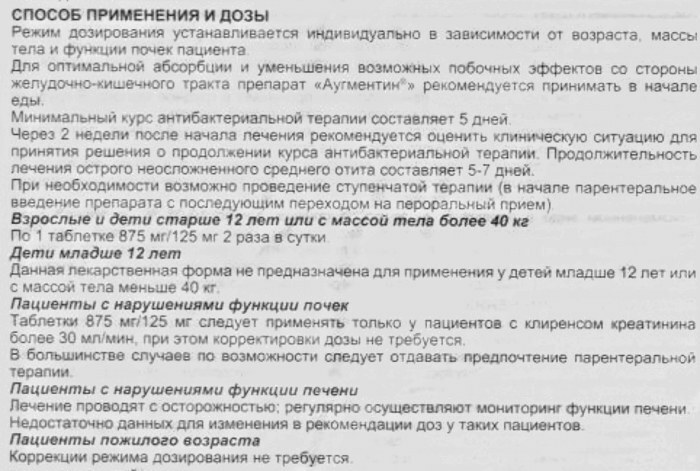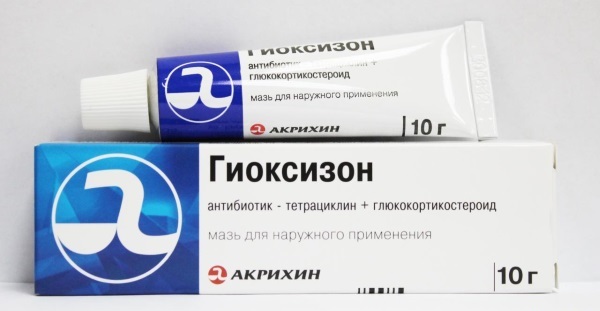Cephalexin is an antimicrobial drug. He, according to consumer reviews, is often prescribed by pediatricians to treat children with infectious pathologies. Before use, you must familiarize yourself with the spectrum of its effects, the peculiarities of the reception and possible contraindications.
Record content:
- 1 Forms of release and composition of the drug
- 2 Pharmacological properties
- 3 Pharmacodynamics and pharmacokinetics
- 4 Indications for use
- 5 Contraindications
- 6 At what age can the drug be used?
- 7 Instructions for use, dosage
- 8 Side effects
- 9 Overdose
- 10 special instructions
- 11 Drug interactions
- 12 Analogs
- 13 Terms, conditions of sale and storage
- 14 Price
- 15 Video about antibiotics cephalosporins
Forms of release and composition of the drug
The product is produced in 2 forms:
-
Capsules - each of them contains 250 mg of the active ingredient.
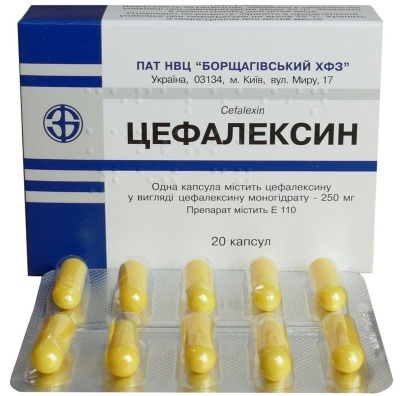
-
Powder (in granules), intended for the preparation of a suspension solution. It is dispensed in bottles of 40 g, which is designed for the preparation of 100 ml of suspension.
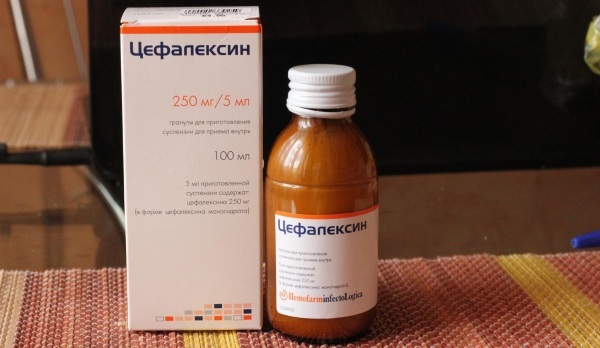
Cephalexin for children
The powder for preparing the suspension has a white or white with a slight shade of yellow, a sweet taste and a specific odor. The active substance of the drug is cephalexin.
The powder also contains sodium benzonate and saccharinate, several flavors to make it easier for children to take (there is apple, raspberry, strawberry and tutti-frutti), sucrose, iron dye, citric acid, sucrose, simethicone and guar gum.
When interacting with water, it forms a yellow (sometimes with an orange tint) suspension with a pronounced fruity aroma.
Pharmacological properties
The drug has a targeted antimicrobial and bactericidal effect on pathogenic microflora.
It disrupts, inhibits cell growth and causes lysis (dissolution and destruction) of a number of microorganisms:
- staphylococci (certain types);
- streptococci;
- Escherichia coli;
- pathogenic bacteria;
- salmonella;
- meningococcal bacteria.
Pharmacodynamics and pharmacokinetics
The antibiotic is well and quickly absorbed from the stomach after ingestion. It has a high bioavailability - 90-95%. Eating food reduces the absorption of the drug. After 1 hour. after ingestion, the maximum antibiotic level is reached in the blood.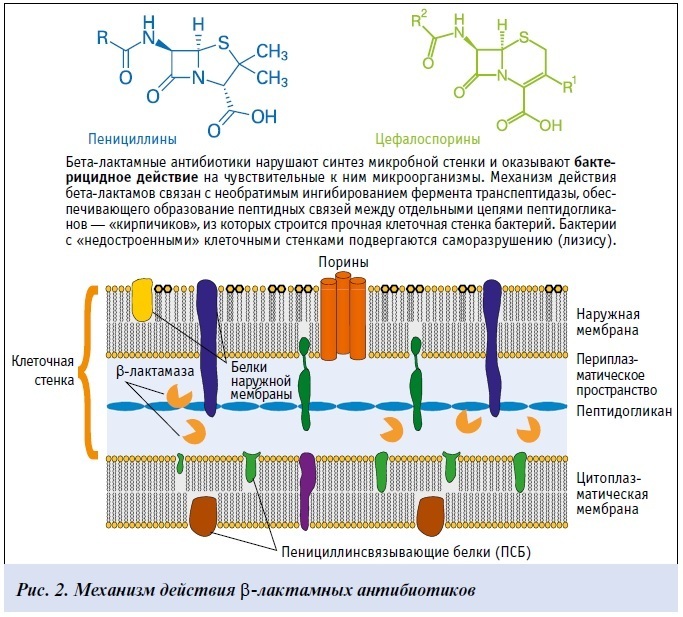
The therapeutic effect lasts for 6 hours. (in the absence of problems with the functioning of the kidneys). The drug is characterized by a uniform distribution in all tissues of the body. The highest concentrations of the antibiotic are observed in the kidneys and liver.
The antibiotic does not lend itself to metabolism - it is almost completely unchanged (80-100%) excreted from the body in the urine for 6-8 hours. In the presence of impaired renal function, the elimination half-life can increase to 5-30 hours.
Indications for use
Cephalexin for children, reviews of which confirm its effectiveness, is used for diseases that were caused by infection.
Among them:
- Diseases of the respiratory system, including inflammation and abscess of the lungs, bronchitis, pleural empyema (accumulation of pus) and others.
- Diseases of the nasopharynx, oropharynx and ears (eg, otitis media, pharyngitis, tonsillitis).
- Diseases of the genitourinary organs (cystitis, urethritis, inflammation of the vaginal mucosa, gonorrhea).
- Lesions of soft tissue (including skin) - furunculosis, purulent inflammation), inflammation of the lymph nodes, dermatitis.
- Infection of bone tissue, as well as joints.
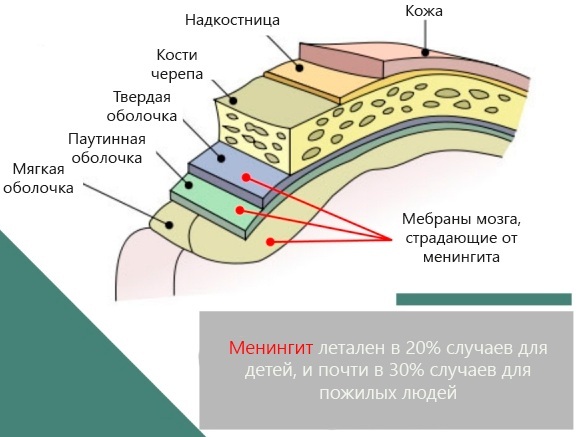
- Meningitis and other infections caused by pathogenic microflora, which are suppressed by the antibiotic.
Contraindications
The drug is prohibited from taking with intolerance to its components (including fructose), with a deficiency of sucrase, during the period of gestation and during lactation.
The exception is when the benefits for the mother are prioritized over the possible risk for the unborn child.. And during lactation, a woman is advised to stop breastfeeding, since the medicine passes into breast milk.
At what age can the drug be used?
Cephalexin for children (reviews indicate the effectiveness of the drug in the treatment of young children) is approved for use from 6 months. An antibiotic can only be prescribed by the attending pediatrician, based on the symptoms and type of disease. The drug should be taken under the constant supervision of a physician.
Cephalexin, when used in the treatment of children under 10 years of age, is used in suspension form. According to reviews, it is very easy to prepare it - just add clean, drinking water to the specified mark into the bottle with the powder and shake everything well.
Instructions for use, dosage
The method of administration, as well as the dosage of the antibiotic, is set individually by the attending pediatrician - the doctor will take into account the symptoms of the disease, its severity and localization of the infection.
The table below shows the standard dosage for the treatment of children of different age groups:
| Patient age | Dosage (daily) |
| Children aged 6 months. and up to a year | 500 mg or 0.5 g. |
| 1-6 years old | 0.5-1 g. |
| 6-10 years old | 1 g |
| 10-14 years old | 1-2 g. |
The standard dosage for adults is considered to be from 250 to 500 mg (must be taken every 6 hours). The daily dosage of the drug should not be less than 1000-2000 mg (or 1-2 g). If necessary, it can be increased to 4 g (by prior agreement with the doctor). The minimum course of antibiotic treatment is 1-2 weeks.
The use of an antibiotic by children has several more features:
- With a body weight of less than 40 kg, it is allowed to take 25-100 mg / kg per day at 4 r. in a day.
- In the treatment of otitis media, the dosage becomes 75 mg / kg (4 r. per day).
- With pharyngitis (if the disease is caused by streptococci, as well as with skin diseases), the daily dose is divided into 2 doses.
- If the infection is severe and there is no improvement in well-being in the first 2 days, the dosage is increased to 100 mg / kg (the medicine is taken up to 6 r. in a day).
The agent must be taken 30-60 minutes before. before eating with water.
Side effects
Cephalexin, like any drug, can cause a number of side effects:
- allergic manifestations in the form of urticaria, rash, itching, swelling.
- Headache, dizziness is possible.
- Decreased appetite, dry mouth.
- Vomiting, nausea.
- Upset stomach, abdominal discomfort.
- Candidiasis of the mucous membranes of the intestines and mouth.
- The development of jaundice, hepatitis.
- Increased bilirubin levels.
- Sleepiness, feeling tired.
- Violation of the process of hematopoiesis (anemia, a decrease in the level of platelets, lymphocytes and neutrophils in the blood).
- Joint pain, connective tissue infection.
- Feverish condition.
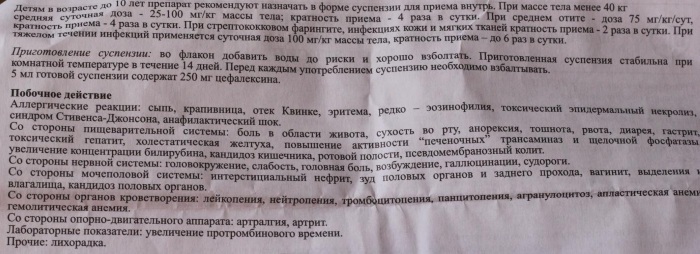
If these symptoms persist within 1-2 days, you should seek the advice of a doctor.
Overdose
Cephalexin for children, reviews of which indicate its safety when taken correctly, can cause a sharp deterioration in well-being in case of an overdose.
You should stop taking antibiotics if:
- constant feeling of nausea;
- prolonged vomiting;
- diarrhea;
- severe pain and discomfort in the upper abdomen;
- the presence of blood in the urine.
These symptoms require medical attention. At home, you can take activated charcoal or other sorbents. In severe cases of overdose, treatment may be necessary in a hospital under the supervision of a medical staff.
special instructions
Taking an antibiotic will be as effective and safe as possible if you follow some recommendations:
- do not take certain tests and tests, since the drug can give a positive reaction (for example, for antibodies, glucose in urine);
- if the functioning of the kidneys is impaired, a slight accumulation of the drug is possible, therefore, it is necessary to constantly monitor this and, if necessary, adjust the dosage;
- dosage adjustment is also required for people with diabetes mellitus, since the medicine contains sucrose;
- the use of alcoholic beverages is not recommended;
- with care it is necessary to drive vehicles, work with various mechanisms, because an antibiotic can cause dizziness and headaches.
Drug interactions
The drug is not recommended to be taken simultaneously with other antimicrobial drugs and diuretics (ethacrynic acid, furosemide), as the risk of kidney damage increases.
Cephalexin affects the effects of drugs aimed at lowering blood sugar. Also, the antibiotic enhances the effect of anticoagulants and reduces the blood clotting index.
Anti-inflammatory drugs (in particular, indomethacin), and analgesics based on salicylic acid reduce the rate of elimination of Cephalexin from the body.
Analogs
Cephalexin for children (reviews indicate that the drug does not always show required efficiency) has several analogues: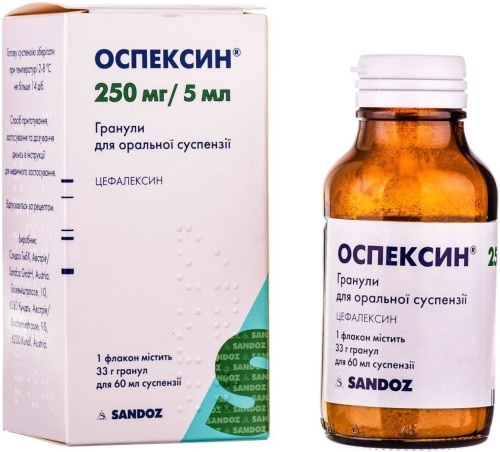
- Ospeksin. The antibacterial agent is commercially available in capsule form, as well as in powder form (used to prepare an oral solution). The main active ingredient is cephalexin. Ospexin is used for systemic use in the presence of infections of the respiratory tract, nasopharynx, oropharynx and inner ear, soft tissues, urinary system, genital area, joints, oral cavity and bones. The standard dose for children weighing less than 40 kg is 25-50 mg / kg. This amount is divided into 2-4 uses per day. For the complete destruction of pathogenic microflora and consolidation of the result obtained, treatment should be carried out for at least 7 days (without interruptions).
- Keflex is a semi-synthetic antibiotic with an active substance in the form of cephalexin. It has a powerful bactericidal effect, destroying the cells of pathogenic microflora. The drug is available in the form of capsules (for use by adult patients) and in the form of a suspension, which is used in the treatment of children. The antibiotic is indicated for use in many infectious processes in the body that are caused by microorganisms that are sensitive to it. For the treatment of children over 12 years old and adults, 250-500 mg of the drug is prescribed every 6 or 12 hours. The treatment schedule for young children is established by the attending pediatrician. The antibiotic is taken half an hour before meals. The duration of treatment is 1-2 weeks.
- Zeff - another antimicrobial agent based on the substance cephalexin. The medicine is sold in several forms (it can be tablets, a granular form for preparing a suspension, as well as a powder for preparing an injection solution). The medicine is used in cases of diseases of the respiratory system, genitourinary organs, joints, bones and muscle tissue, which are caused by an infection of bacterial origin. The antibiotic is not taken in the presence of hypersensitivity to the components of the drug. How safe and appropriate it is to take an antibiotic during pregnancy, during the lactation period, with renal failure, as well as in the treatment of children who are less than 6 months old, the doctor can determine.
The antimicrobial drug Amoxicillin has almost identical effect on the body with Cephalexin. These 2 drugs are part of the same group of antibiotics called cephalosporins. The active ingredient of Amoxicillin is amoxicillin trihydrate. After ingestion, it is completely absorbed from the stomach and has a therapeutic effect in 1-2 hours.
The antibiotic is used on its own to treat inflammatory diseases (tonsillitis, organ disease digestion, gynecological infections, gonorrhea, bronchitis and others) caused by infection with a bacterial microflora.
Also, the drug has an effective effect as part of a complex treatment with Metronidazole (an antimicrobial drug for the treatment infections caused by protozoa) diseases such as stomach ulcers, duodenal ulcers and chronic gastritis located in acute phase.
The daily dosage of the antibiotic depends on the age of the patients:
- If children are 2 to 5 years old, they need to take 125 mg of the drug;
- children who have reached the age of 5-10 years - 250 mg;
- Adults and children who are 10 or more years old show a dose of 250-500 mg.
With a severe course of the disease, the maximum dosage can be no more than 1 g. When the antibiotic is taken by children weighing less than 40 kg, the dosage will be 20-100 mg / kg. This amount of antibiotic should be divided into 2-3 uses. These schemes can be adjusted by the attending physician.
The antibiotic Oxacillin has a similar therapeutic effect with Cephalexin.
Its active ingredient is sodium oxacillin, which inhibits the cells of a variety of bacteria (staphylococci, streptococci, bacterial bacillus causing diphtheria, gonorrhea, meningococcal infection).
The main indication for the use of an antibiotic is:
- The presence of an infectious disease accompanied by an inflammatory process, which is caused mainly by staphylococci.
- Suspicion of infectious diseases of soft tissues, skin, joints, bones, bacterial meningitis, syphilis, meningitis, cystitis, pneumonia, sepsis, cholecystitis, infected burns, endocarditis or sinusitis (the drug is taken before laboratory results).
The standard dosage of an antibiotic for the treatment of children weighing less than 40 kg is 12.5-25 mg / kg (taken every 6 hours). For adult patients and children weighing over 40 kg, the daily dosage is 0.5-1 g every 4-6 hours. Oxacillin is prohibited for use in case of allergy to the drug or its individual substances.
It is taken with caution when:
- bronchial asthma;
- chronic renal failure;
- carrying a child;
- lactation period.
Terms, conditions of sale and storage
The sale of the antimicrobial drug is carried out from pharmacies with a doctor's prescription.
So that the effectiveness of the medicine does not decrease, it is necessary to adhere to simple rules for its storage:
- The place must be dry and out of direct sunlight.
- The optimum storage temperature is 15-25 0WITH.
- The prepared suspension solution can be used within 2 weeks - it can be stored in refrigerator or at room temperature (before each use, it must be well shake).
- Do not use the medicine after the expiration date, which is 3 g. from the production date.
Price
In online pharmacies, the average cost of an antibiotic produced in the form of a granular powder (40 g) is 60 rubles. The price of the medicine in capsules depends on the concentration of the active substance in 1 capsule. So, for 16 capsules with 250 mg, you will have to pay about 80 rubles. The price of the same number of capsules, but with a concentration of 500 mg of the substance, starts from 70 rubles.
The antimicrobial drug Cephalexin is used to treat a variety of infectious diseases. According to reviews, it has an effective effect from the first use and is easily tolerated by children.
Video about antibiotics cephalosporins
Pharmacology of beta-lactams:


